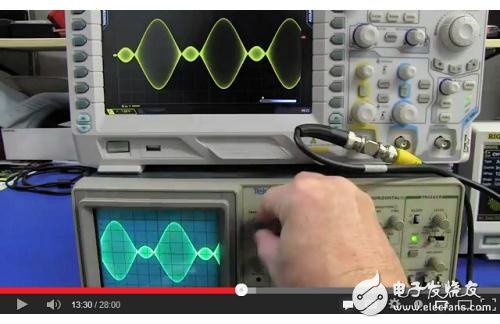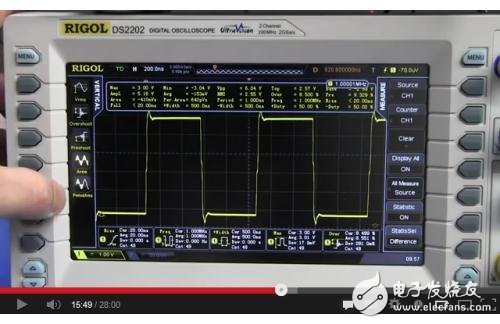Numerous products are moving in a more intelligent direction, and we must make full use of the resources provided by the All Programmable world to take the lead in the competition. This truth is what I realized in an accidental experience. In a new video from Dave Jones EEVblog (video URL: http://v.youku.com/v_show/id_XNTM5MzcwNzMy.html), the RIGOL DS1052E digital oscilloscope launched by RIGOL four or five years ago The DS2072, a new generation of "economical" digital oscilloscopes introduced last year, was compared. (Readers of the Motor Trend magazine should know that the magazine refers to the "comparo" for a comparison of two different models.)
RIGOL DS1052E is a 50MHz DSO. It was priced at $800 when it was first launched. It is now priced at $329 (excluding tax). This dual-channel 50MHz DSO has a sampling rate of 1GSa/s and offers a 5.7-inch 320x240 pixel LCD display, 1M sample point memory depth, hardware frequency counter, some basic trigger modes, and "basic waveform detection." Features". Dave calls the RIGOL DS1052E an "unbreakable small oscilloscope."
The new DS2072 DSO is priced at $839 (excluding tax) and is a dual 70MHz DSO with a sampling rate of 2GSa/s. It offers a larger 8-inch 800x480 pixel LCD screen with 14M sample point memory depth (up to 56M sample points via software upgrade); segmented memory for capturing unusual high frequency bursts with efficient memory resolution Up to Gigabit level (RIGOL is called waveform recording mode); anti-aliasing mode is also provided; higher analog modulation display grayscale provides more signal microsecond detail (Dave calls it "intensity level" or "digital fluorescence" "display"; with high resolution mode with boxcar averaging for higher effective vertical resolution (see my discussion on improving the analog-to-digital converter ENOB: Do you need to increase the resolution of the analog-to-digital converter?) More information on fast analog-to-digital conversion, oversampling, decimation, and ENOB); provides trace tracking support with masks, Pass/Fail detection for statistical results; provides Ethernet LXI instrument ports, and more advanced triggering capabilities (including Edge, pulse width, short pulse, window, N edge, slope, set/hold, video, RS232, I2C, USB, etc.), hardware frequency counter and a large number of Waveform signal analysis and statistical functions (frequency, rise time, phase delay, FFT, etc. waveform math). RIGOL DS2072 has been on the market for about 9 months.
Keep in mind that this DSO is priced at $839 (excluding tax). (The larger capture storage capacity and advanced trigger mode increase costs.)
Below is a screenshot of the Dave demo video showing the comparison of the RIGOL DS2072 DSO multi-level grayscale with the decades-old Tektronix 2225 oscilloscope analog screen.

These two devices look similar?
Take a look at the waveform data characteristics of the RIGOL DS2072 DSO displayed by Dave:

Dave downloads thousands of 14k waveforms to the PC via the Ethernet LXI port of the RIGOL DS2072 DSO. Later, when he generates a waterfall histogram for these waveforms, the analysis data rushes to the highest value.
RIGOL DS2072 DSO achieves "intelligence". Its great value lies in advanced analysis capabilities. Dave said: "The difference is simply too big. The old product is no match for it."
As shown in the 28-minute video clip from Dave Jones, many different types of products have undergone the same feature upgrades. Now the entry-level DSO can achieve the functions and features that DSO can't match at any price five years ago, and the entry-level DSO five years ago has now halved the price, which is an ultra-low-cost DSO. This is the result of intelligence, which is to better serve the needs of customers through the Smarter system. Outstanding new products become smarter, while older products in the past can be sold at half price.
At the end of the video, Dave said: "What kind of technology will we welcome in five years?" This is definitely a good question. What will happen in the future? Immediately I will think that the future DSO will support the touch screen function, why do you have to use buttons to control the waveform view? Modern people have long been accustomed to using finger touch manipulation. I can easily predict that an entry-level DSO will run a full Android system or a GUI similar to Android, and will use dual processors (one for GUI and analytics, and one for RTOS and bare metal control).
As with the development of DSO, as people's expectations continue to improve, most electronic products will be perfect and powerful.
Single Phase Vfd,220V Frequency Inverter,Ac Frequency Inverter,High Frequency Inverte
WuXi Spread Electrical Co.,LTD , https://www.vfdspread.com